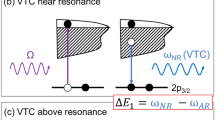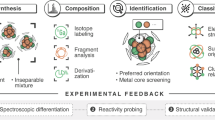Abstract
SMALL metal clusters, containing of the order of 10 to 10,000 atoms, are of interest both for exploring the fundamental question of how atomic-scale properties develop into bulk properties and because such clusters are expected to have interesting optical, electronic and magnetic properties1. The expectation is that bulk-like metallic behaviour will become increasingly evident as the cluster size increases, but at what stage bulk properties appear is not yet clear. Here we present results of a study of the platinum cluster compound Pt309(Phen*)36O30±10 (refs 2–4), in which we use Mossbauer spectroscopy to investigate the bonding environment of the Pt atoms. Because Pt lacks a good Mossbauer isotope, we transform a fraction of the196Pt atoms in the clusters into Mössbauer nuclei197Au by neutron irradiation. The resulting spectra show that the inner (147–atom) core of the Pt cluster exhibits a metallic character like that in the bulk metal, whereas the surface atoms are not bulk-like. These bulk-like metallic properties may be acquired by metal-cluster cores as small as about 150 atoms.
This is a preview of subscription content, access via your institution
Access options
Subscribe to this journal
Receive 51 print issues and online access
$199.00 per year
only $3.90 per issue
Buy this article
- Purchase on Springer Link
- Instant access to full article PDF
Prices may be subject to local taxes which are calculated during checkout
Similar content being viewed by others
References
Moskovits, M. (ed.) Metal Clusters (Wiley, New York, 1986).
De Jongh, L. J. et al. in Physics and Chemistry of Finite Systems: From Clusters to Crystals Vol. 2 (eds Jena, P. et al.) 839–851 (Kluwer, Dordrecht, 1992).
Schmid, G. Chem. Rev. 92, 1709–1727 (1991).
Schmid, G., Morun, B. & Malm, J. O. Angeur. Chem. int. Edn engl. 28, 778–780 (1989).
Smit, H. H. A., Nugteren, P. R., Thiel, R. C. & de Jongh, L. J. Physica B153, 33–52 (1988).
Thiel, R. C., Benfield, R. E., Zanoni, R., Smit, H. H. A. & Dirken, M. W. Struct. Bonding 81, 1–39 (1993).
Mulder, F. M., van der Zeeuw, E. A., Thiel, R. C. & Schmid, G. Solid St. Commun. 85, 93–97 (1993).
van der Putten, D., Brom, H. B., de Jongh, L. J. & Schmid, G. in Physics and Chemistry of Finite Systems From Clusters to Crystals Vol. 2 (eds Jena, P. et al.) 1007 (Kluwer, Dordrecht, 1992); Z. Phys. D26, S21–24 (1993).
Baak, J., Brom, H. B., de Jongh, L. J. & Schmid, G. Z. Phys. D26, S30–33 (1993).
Simopoulos, A. & Vogl, S. Phys. Status Solidi 59, 505–527 (1973).
van Staveren, M. P. J., Brom, H. B. & de Jongh, L. J. Phys. Rep. 208, 1–96 (1991).
Viegers, M. P. A. & Trooster, J. M. Phys. Rev. B15, 72–83 (1977).
Shenoy, G. K. & Wagner, F. E. Mössbauer Isomer Shifts 906, (North Holland, Amsterdam, 1978).
Author information
Authors and Affiliations
Rights and permissions
About this article
Cite this article
Mulder, F., Stegink, T., Theil, R. et al. Metallic behaviour in a Pt309 cluster revealed by 197Au Mössbauer spectroscopy. Nature 367, 716–718 (1994). https://doi.org/10.1038/367716a0
Received:
Accepted:
Issue Date:
DOI: https://doi.org/10.1038/367716a0
This article is cited by
-
27Al NMR Study of the Metal Cluster Compound Al50C120H180
Journal of Cluster Science (2007)
-
Quantum-size effects in the thermodynamic properties of metallic nanoparticles
Nature (1996)
Comments
By submitting a comment you agree to abide by our Terms and Community Guidelines. If you find something abusive or that does not comply with our terms or guidelines please flag it as inappropriate.



